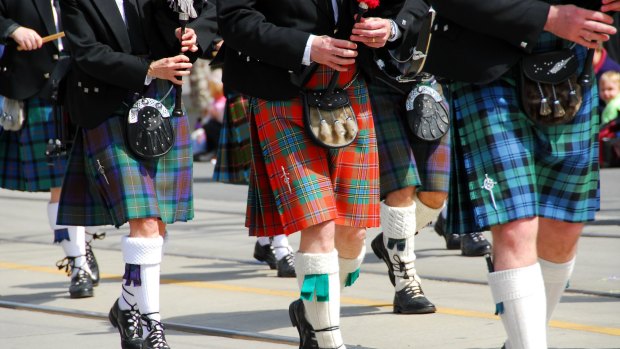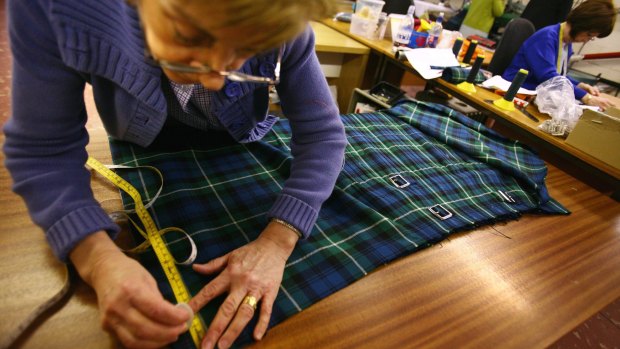This was published 1 year ago
Kilts in Scotland: Where to learn about the history of the garment and clan tartans

Kilts have been around in one form or another since the 16th century. Credit: Elenathewise
Everywhere I look, I see men wearing kilts. But, to be fair, people all over are wearing a peculiar array of garb, from a chanting flock of clowns decked out in fire-orange to a pyjama-clad man riding a unicycle across a tightrope. I'm here during The Edinburgh Festival Fringe, so it's most likely not a true representation of what most people wear day to day.
When I meet with Howie Nicholsby, the founder of Edinburgh's 21st Century Kilts, he explains that kilts are not typically worn every day. "The kilt is worn to formal events by some Scotsmen, and sometimes women," he explains. "But I've worn a kilt every day since 1999 and hope to inspire more people to have the option of a kilt."
There was a time when kilts were worn daily, particularly by Scots living in the Highlands and northern Lowland areas of Scotland, and kilts have been around in one form or another since the 16th century. "Back then they were made up of huge rolls of material – most likely cloth or tartan – and designed to be worn and used in all sorts of ways – coat, pillow, sleeping bag and the like," Nicholsby tells me.

There are not many kilt-makers selling traditional kilts, but some companies try to offer a modern version these days.Credit: Getty Images
Nicholsby is wearing a denim kilt as we walk and talk. With three distinct pockets and a stylishly angular cut, his garment is unquestionably striking. He seems completely comfortable and has no qualms about his choice. "I made the life choice to wear only kilts when I was 21," he says. "I haven't owned jeans or a suit for over two decades."
Although Nicholsby's specialty is modern kilts, he learned to make the more traditional kilt when working at his parent's shop – Geoffrey (Tailor) Kilt Makers – and uses his knowledge and experience when creating his own kilts. "My great grandmother made kilts, my grandmother and grandfather made them, and my dad is a master tailor."
It's estimated that there are about 400-500 clan and family associations in Scotland, however not all clans have a tartan and there is little evidence that tartans were associated with any family or clan names before the mid-18th century. A study by Edinburgh University students found that only about 30 per cent of the population had an association with a clan. Still, if you have Scottish lineage and you visit Scotland, you might be tempted to search out your clan's tartan.
When I visit Highland House of Fraser in Inverness later in the week, I hear a chap with an American accent enquiring whether a staff member could help him find his clan tartan. I see the same man a little later upstairs, in the Scottish Kiltmaker Visitor Centre where a small exhibition touches on the tradition of kilt-making and provides an opportunity to watch local kilt-makers at their craft. He has a big grin on his face and I conclude that he was able to trace his lineage and order a traditional kilt that will no doubt one day become a family heirloom.
Nicholsby tells me that there are not many kilt-makers selling traditional kilts, but that some companies try to offer a modern version these days, although it's nothing like his work. "There aren't too many people who specialise in modern kilts," he says. "I remember sitting in my parents' workshop making a kilt, having just recovered from an acid psychosis in 1996, and I realised then and there that I wanted to branch out and make my own kind of kilts. My ethos hasn't really changed since I was 18. Anything that a man wears as trousers, I want to explore and make into a kilt – corduroy, leather, even transparent PVC."
I don't have any doubt that Nicholsby will go on to create kilts out of whatever material he chooses, and judging by the crowd at The Edinburgh Festival Fringe, he'll find customers who will gladly purchase the innovative creations… even the transparent PVC variety.
THE DETAILS
FLY
Singapore Airlines operates over 110 flights per week from seven Australian cities to Singapore, with two daily flights connecting onwards to Frankfurt then connections to Edinburgh with alliance partner, Lufthansa. See singaporeair.com.
VISIT
Howie Nicholsby sees customers at 57/59 High Street, Royal Mile, Edinburgh. Appointments take up to two hours and your customised kilt will be ready six to eight weeks later. Nicholsby offers worldwide shipping. See 21stcenturykilts.com.
STAY
Gleneagles Townhouse is a charming luxury hotel with character-filled rooms and thoughtfully-designed public spaces. See gleneagles.com.
MORE
Sign up for the Traveller Deals newsletter
Get exclusive travel deals delivered straight to your inbox. Sign up now.